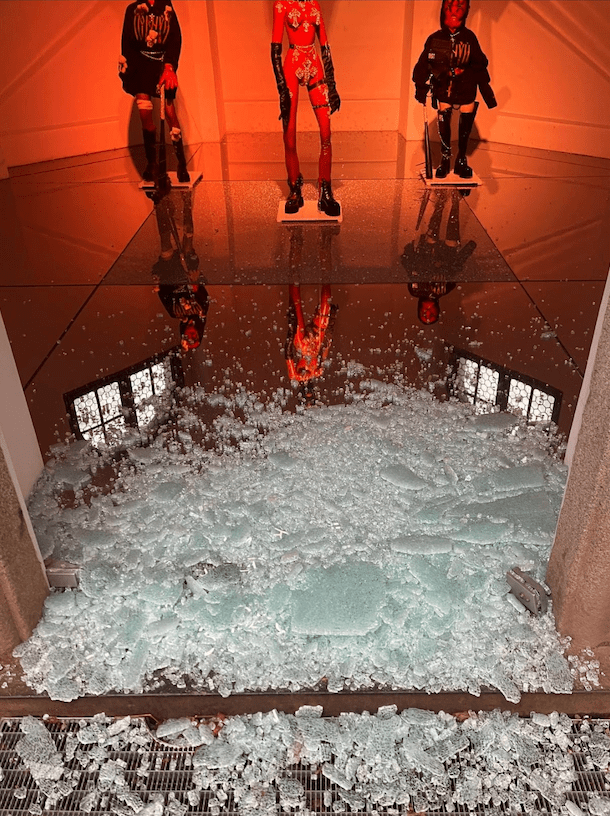An exhibition space at an Austrian contemporary art museum was damaged on Saturday, December 7, in an apparent act of vandalism targeting a feminist art installation by Nadya Tolokonnikova, the founder of the Russian activist and performance art group Pussy Riot.
The installation, a set of balaclava-clad red mannequins in punk platform black boots titled “Pussy Riot Sex Dolls,” is part of Nadya Tolokonnikova’s exhibition RAGE at the OK Center for Contemporary Art in Linz, Austria (OK Linz). Images reviewed by Hyperallergic show a shattered glass door at the entrance of a former Marienkapelle, a long-deconsecrated chapel that the museum uses as an exhibition space.
OK Liz described the incident as “an act of violence” in an Instagram post. The museum said a stone was used to destroy both the door and glass floor of the exhibition. No surveillance footage was captured and there are no witnesses of the suspected individual or individuals, Tolokonnikova told Hyperallergic.
OK Linz has not yet replied to Hyperallergic’s request for comment.

While the artwork was unscathed apart from a few fragments of glass that landed on the dolls, Tolokonnikova, who lives in geographic anonymity because she is on a Russian wanted list, told Hyperallergic in an interview that the incident appears not to be a “random act,” but rather a “fundamentalist act against feminist symbols.”
The mannequins, the artist said, are second-hand sex dolls she purchased on Facebook Marketplace and dressed to replicate Pussy Riot members.
“I placed the dolls in the chapel of the Holy Virgin because I believe feminists are sacred, and I’m convinced that the Virgin Mary is a feminist too,” Tolokonnikova said in a statement.
The exhibition’s title comes from a 2021 Pussy Riot song calling for the release of political prisoners, including the opposition leader Alexei Navalny, who died in disputed circumstances while in prison earlier this year and whom Tolokonnikova described as a friend.

The exhibition features a four-meter-long (~13.2 feet) Damocles sword hanging over visitors’ heads, meant to evoke the danger activists live under, and an installation dedicated to the performance “Putin’s Ashes” (2022) that landed Tolokonnikova on a Russian wanted list. Tolokonnikova and Pussy Riot’s exhibition also includes the new Icon series, portraits of women in balaclavas decorated with 13th-century Slavic church calligraphy.
Russia arrested Tolokonnikova in absentia last November for her role in Pussy Riot’s “Putin’s Ashes” (2022) performance, in which she and 11 other balaclava-wearing women burnt an image of Vladimir Putin and bottled ashes of the dictator’s image. She previously was sentenced to two years in prison over Pussy Riot’s 2012 anti-Putin feminist punk performance protest “Punk Prayer” inside the Orthodox Christian Christ the Savior Church in Moscow.
The incident at OK Liz occurred the evening before the holy day of the Solemnity of the Immaculate Conception of the Blessed Mary, celebrated on December 8. Earlier this year at a Linz cathedral, a sculpture included in a show of women artists that depicted the Virgin Mary giving birth, titled “Crowning,” was beheaded after conservatives characterized it as blasphemous due to its portrayal of the birth of Christ, which is considered to be a mystery of the faith. The sculpture’s head has not yet been recovered.
Tolokonnikova believes that these seemingly reactionary incidents are driven by a desire “to not let artists question or even think about these deeply entrenched roles of feminine religion and broader culture.”
“It’s something that I saw in Russia,” Tolokonnikova told Hyperallergic. “We do purely symbolic acts of protest, and even for that, we got jailed. It’s troubling to see it happening in Europe.”
Tolokonnikova said she will leave the glass as is for the remainder of the exhibition, which has been extended twice because of its popularity and will now close in June. She said one of the exhibition’s curators, Michaela Seiser, suggested leaving the remnants of the incident as a “message.”
Tolokonnikova also attributes the incident at her exhibition to a rise of right-wing movements globally. In September’s preliminary elections for chancellor, the country’s Freedom Party, which has origins in Nazi ideology and is described as Russia-friendly, won its first national election since World War II.
Since landing on Russia’s wanted list, Tolokonnikova said she cannot travel to nations that have extradition treaties with her home country.
“This kind of art has real-life consequences,” Tolokonnikova said.
